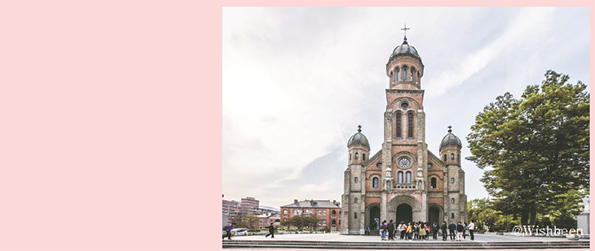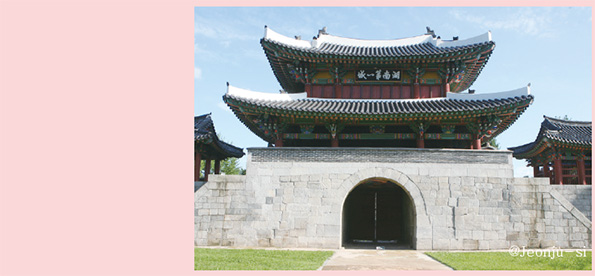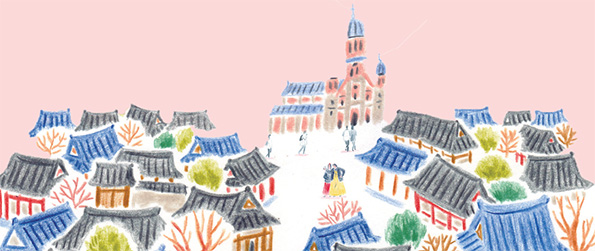
Jeonju Hanok Village is a famous tourist spot located in Pungnamdong, Wansan-gu, Jeonju-si, Jeollabukdo. The popularity of Hanok villages is growing day by day, drawing not only domestic tourists but also foreign ones. Since 2016, ten million tourists have visited a Hanok village each year. Jeonju is one of the more popular travel destinations, capturing the eyes of tourists with a variety of food and special activities. Also, with traditional culture and urban culture co-existing together, visitors can see the Jeondong Cathedral, Kyung-gi-jeon(the home of the founder of the Joseon Dynasty, Yi Seong-gye), Jeonju Hyanggyo(an educational institution) and Jeonju Pungnammun(the southern gate of Jeonju City).
On Children’s Day, CBT reporters traveled to Jeonju Hanok Village to introduce the benefits of visiting a Hanok village. As soon as they arrived, the reporters saw a magnificent building called the Jeondong Cathedral. French missionaries built the Jeondong Cathedral in 1914. It became the representative attraction of Jeonju as it was the biggest and oldest modern architecture in the Ho-nam District. This Romanesque cathedral symbolizes a blend of traditional culture and Western culture. The beauty of the curves and the warmth, like a mother’s arms, are the unique features of the Jeondong Cathedral.
The Jeondong Cathedral is free to tourists, but it is prohibited to tour during a mass. If vIsitors want to look around inside, they should check the mass times in advance. Doing that might help touring without any glitches. Most tourists who visit Jeonju Hanok Village like to take pictures of the beautiful cathedral from its background. This spot is renown as a photo zone, and the picture is considered to be a once in a lifetime photo.
On the streets of Jeonju Hanok Village, lots of tourists stroll dressed in Hanboks(Korean traditional clothes) or Kyung-sung dresses(a trendy fashion during the enlightenment period) while eating food and taking pictures. There are many clothing rental shops around Jeonju Hanok Village. Kyung-sung dresses went viral recently through SNS, so renting Kyung-sung dresses is on the increase. The rental costs of a Hanbok or a Kyung-sung dress are 20,000 and 30,000 respectively for 3 hours.
With people wearing Hanboks and Kyung-sung dresses, the streets of Jeonju Hanok Village looked like a Mr. Sunshine filming site. Mr. Sunshine is a popular Korea drama which describes the times just before the Japanese colonial era. To blend in, the reporters wore Kyung-sung dresses and took a look around Jeonju Hanok Village. Wearing Kyung-sung dresses and wandering from place to place made them feel like they were the main characters in the drama. Hurrying around made them hungry, so they visited a restaurant called Daurang, which is famous for handmade dumplings. The dumplings were so delicious because they were filled with lots of vegetables, meats and shrimps. It was worth paying the 2,500 won. That day, the reporters could not eat other foods like meat griddled pancakes and octopus as the queues were too long because of the many tourists.
Next, the reporters visited Kyung-gi-jeon, which is a representative site in Jeonju Hanok Village, and it is recommended as a must-see domestic destination. Kyung-gi-jeon is designated as Historic Site No. 339, and the main hall, which preserves the portrait of King Yi Seong-gye, is National Treasure No. 317. Also, Jo Gyeong-myo, Joseon Pavilion, and Tae-sil can be seen in Kyung-gi jeon. Jo Gyeong-myo is the place ere the ancestral tablets of Lee Han-gong are enshrined. Joseon Pavilion preserves various Joseon records, and Tae-sil is where King Yejong’s umbilical cord was buried.
Originally, Kyung-gi-jeon was bigger, but during the era under the colonial rule of imperial Japan, half of Kyung-gi-jeon was destroyed, so, regrettably, a Japanese school was built there. The entrance fee is 2,000 won per person.
That day, an event concerning Joseon Wangjo-sillok(the true record of the Joseon Dynasty) was enacted to celebrate Children’s Day. Old records of books were dried in the wind to prevent them from decaying due to moisture. This special event was held for only one day, but Kyung-gi-jeon holds other events for tourists such as Kyung-gi-jeon People and A Walk with the King. Kyung-gi-jeon People is a new program where tourists can meet actors dressed as various historical people and hear Jeonju’s exciting history and culture from them. This program occurs every Thursday and Friday at 10 a.m. Also, A Walk with the King is a night program where tourists can get an explanation of Kyung-gi-jeon from a tour guide. A Walk with the King is so famous that tickets are sold out for every session. It is held every Saturday at 8 p.m. for 100 minutes and only for 100 people. These two events will run from May to September. Various other events are offered to Jeonju City tourists, so checking events and times prior to going is recommended.
Another activity that tourists can enjoy is renting a motorcycle. The reporters rented a two-seater electric motorcycle to tour the large Jeonju Hanok village. Renting a motorcycle costs 20,000 won per hour. Anybody can rent a motorcycle, even those without license. Renting a motorcycle is a recommended activity as tourists can arrive where they want quickly and they can enjoy the speed while talking with a partner.
Riding a motorcycle, the reporters visited Jeonju Hyanggyo, which is a famous filming site for Sung-kyun-kwan Confucianism Student. Jeonju Hyanggyo was an educational institution for the noblemen’s children during the Joseon Dynasty. Jeonju Hyanggyo is well-preserved, and it is located relatively far away from the Hanok village, so it is in harmony with nature and tourists can feel the coolness and elegance of the traditional architecture.
Last, the reporters visited Jeonju Pungnammun. Pungnammun is the southern gate of Jeonju City, and it was destroyed during the Japanese invasion of Korea in 1592. Under the rule of King Yeongjo, Pungnammun was rebuilt. In 1907, the other gates were also ruined by the Japanese, so only Pungnammun remained. Pungnammun is National Treasure No. 308. Sadly, the inside of Pungnammun was destroyed, so tourists can see only parts of the fortress.
The reporters finished the trip eating at Jeonju Bibimbap. Jeonju Bibimbap is the most popular restaurant in Jeonju. Tourists can find the restaurant easily in the Hanok village. It costs 10,000 won per person. Mixed rice with various vegetables, meats and gochujang(Korean traditional chili sauce) are not only delicious but also healthy.
Jeonju Hanok Village was a meaningful and wonderful site. The Hanok village was filled with lots of activities and places to see. It would be good enough for a one-day trip, but traveling for two days and one night would be better.
The reporters greatly recommend Jeonju Hanok Village as a touring place to our CBNU students who want to travel during weekends and summer vacation.
By Baek Han-na l backna@cbnu.ac.kr
By Nam Min-woo l mw38 @cbnu.ac.kr



 All
All Experience
Experience






 Baek Han-na & Nam Min-woo
Baek Han-na & Nam Min-woo











